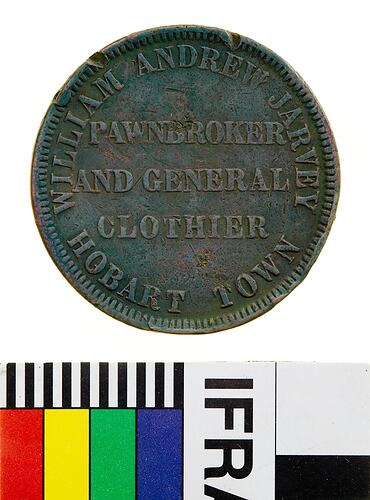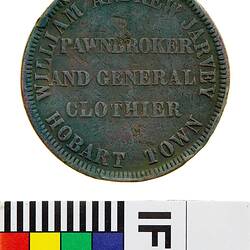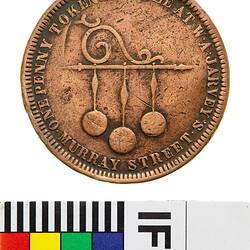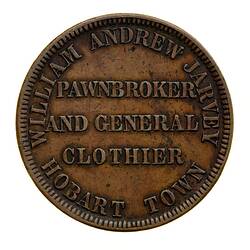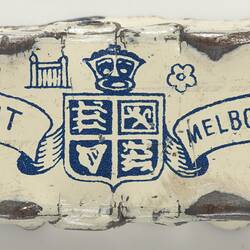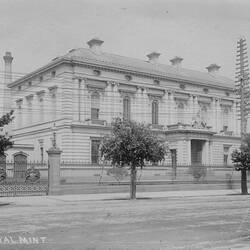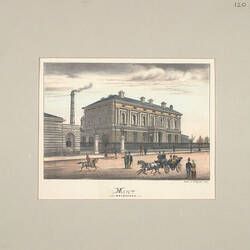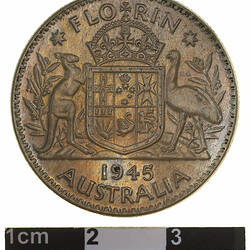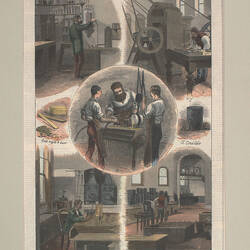Summary
Copper one Penny Token, minted by an unknown British Mint, circa 1860. Issued by William Andrew Jarvey, a Pawnbroker, in Hobart. William Andrew Jarvey arrived in Tasmania on 8 April 1844 and was appointed a Police Constable. In 1849 he obtained permission to marry Catherine Jane Shaw, a 25 year-old Irish convict. The following year he resigned his commission and became the Schoolmaster at the Cascades, outside Hobart. In 1854 he left the school and established himself as a Clothier and Pawnbroker in Murray Street, Hobart. He kept this business until 1862 and then attempted farming at Wattle Grove in the Huon Valley, south of Hobart, but gave up his efforts by November of that year. He then convinced the owners of the steamer Titania that he was a suitable Captain for their ship, supplying mining communities in New Zealand. In April 1864, Catherine Jarvey sold the farm and, with their five children, followed Jarvey to New Zealand. In August Jarvey beat his wife until she was unconscious. The following month he purchased some rat poison from a chemist, and according to the published versions of the trial, Catherine Jarvey was taken ill with 'fits' within a few days of the purchase. On the evening of 26 September, Jarvey administered a fatal dose of strychnine and his wife died of an epileptic fit. Jarvey was tried twice for his wife's murder and eventually found guilty, he was hanged on 25 October 1865, the first man to be hanged in Dunedin.
Physical Description
A round copper token (34 mm diameter) featuring the name, address and business of the issuer: William Andrew Jarvey, Murray St. Hobart Town, pawnbroker and general clothier. It features three decorated balls hanging from a wall bracket. This token has been cleaned and the obverse has re-toned dark green.
Obverse Description
Legend in five lines, the first and last curved around the rim: WILLIAM ANDREW JARVEY / PAWNBROKER / AND GENERAL / CLOTHIER / HOBART TOWN
Reverse Description
At centre three decorated balls hanging from a wall bracket around, . ONE PENNY TOKEN PAYABLE AT W.A. JARVEY'S . MURRAY STREET
Edge Description
Plain
More Information
-
Collection Names
-
Collecting Areas
Clothing & Textiles, Numismatics & Philately, Working Life & Trades
-
Acquisition Information
Transfer from Melbourne Branch of Royal Mint, 11 Jan 1978
-
Date Issued
circa 1860 AD
-
Issued By
William Andrew Jarvey - Pawnbroker, Hobart, Greater Hobart, Tasmania, Australia, 1855-1865
-
Previous Collection
-
Inscriptions
Obverse: WILLIAM ANDREW JARVEY PAWNBROKER AND GENERAL CLOTHIER HOBART TOWN Reverse: ONE PENNY TOKEN PAYABLE AT W.A. JARVEY'S MURRAY STREET
-
Denomination
-
Series
-
Material
Copper
-
Axis
12
-
Classification
-
Category
-
Discipline
-
Type of item
-
Dimensions
34 mm (Outside Diameter), 11.579 g (Weight)
-
Shape
Round
-
References
The Jarvey token issue required three reverse dies but only one obverse die. The reverses are identified by variations in the three balls and the wall bracket. They can be quickly identified as follows: Reverse Support of balls centre ball diameter 1 Bars 4.2 mm 2 Chains 6.4 mm 3 Chains 7.0 mm Andrews recorded a fourth reverse die "the bar is longer and points between T and O and the right is closer to the initial W" This is matched on a token in the Dixon collection but that piece is badly damaged and the described variation could be caused by the physical damage to the token and not represent a different die. Confirmation of this fourth reverse die is needed. Die combinations recorded for Jarvey are, A/1 (this token), A/2, A/3
[Book] Andrews, Arthur. 1921. Australasian Tokens and Coins., No. 300
[Book] Heyde, Gilbert C. & Skinner, Dion H. 1967. Unofficial Coins of Colonial Australia and New Zealand., No. 135
-
Keywords
Clothing, Clothing Trade, Pawnbrokers, Retail Trade, Retailing, Timber
